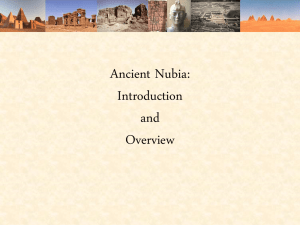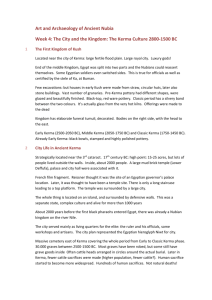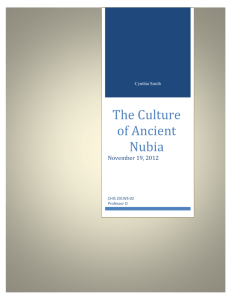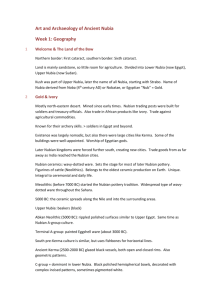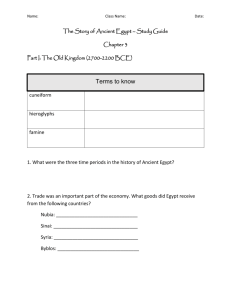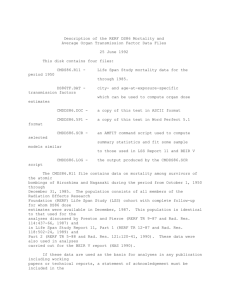Ancient Nubia - WordPress.com
advertisement
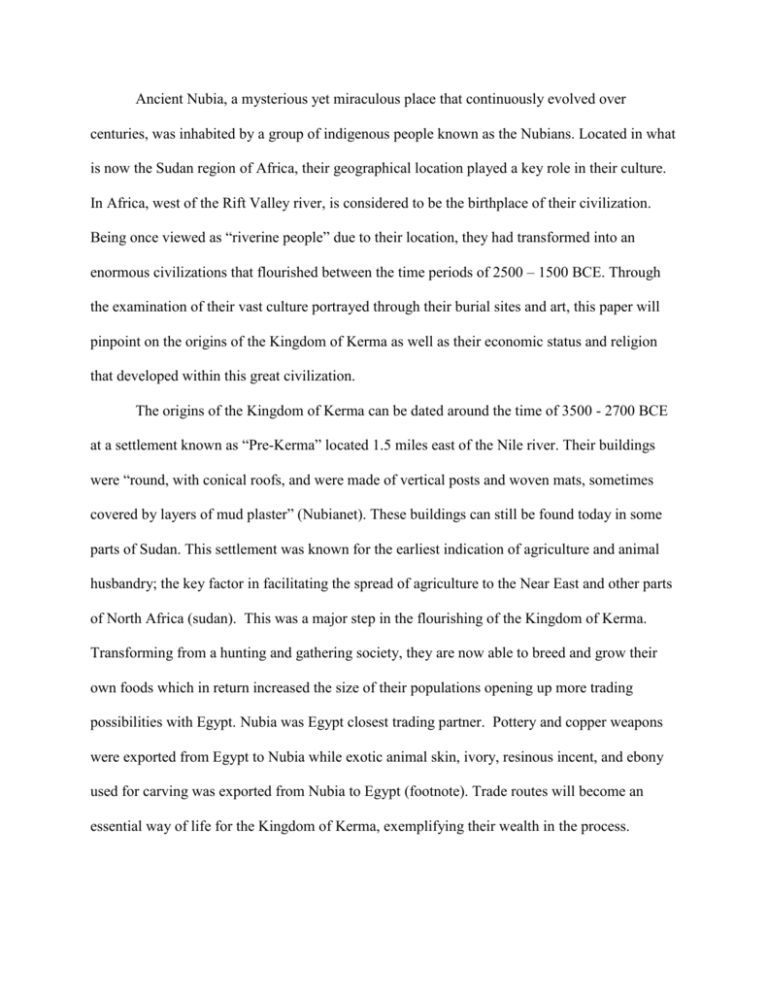
Ancient Nubia, a mysterious yet miraculous place that continuously evolved over centuries, was inhabited by a group of indigenous people known as the Nubians. Located in what is now the Sudan region of Africa, their geographical location played a key role in their culture. In Africa, west of the Rift Valley river, is considered to be the birthplace of their civilization. Being once viewed as “riverine people” due to their location, they had transformed into an enormous civilizations that flourished between the time periods of 2500 – 1500 BCE. Through the examination of their vast culture portrayed through their burial sites and art, this paper will pinpoint on the origins of the Kingdom of Kerma as well as their economic status and religion that developed within this great civilization. The origins of the Kingdom of Kerma can be dated around the time of 3500 - 2700 BCE at a settlement known as “Pre-Kerma” located 1.5 miles east of the Nile river. Their buildings were “round, with conical roofs, and were made of vertical posts and woven mats, sometimes covered by layers of mud plaster” (Nubianet). These buildings can still be found today in some parts of Sudan. This settlement was known for the earliest indication of agriculture and animal husbandry; the key factor in facilitating the spread of agriculture to the Near East and other parts of North Africa (sudan). This was a major step in the flourishing of the Kingdom of Kerma. Transforming from a hunting and gathering society, they are now able to breed and grow their own foods which in return increased the size of their populations opening up more trading possibilities with Egypt. Nubia was Egypt closest trading partner. Pottery and copper weapons were exported from Egypt to Nubia while exotic animal skin, ivory, resinous incent, and ebony used for carving was exported from Nubia to Egypt (footnote). Trade routes will become an essential way of life for the Kingdom of Kerma, exemplifying their wealth in the process. The Kingdom of Kerma was a prosperous civilization that dominated the trade routes during this time period. Despite their rivaling history, the Nubians and Egyptians had a strong alliance in trading. If anything remotely seemed threatening to the trade routes between the two, a form of action will be taken to secure their safety. The Nubian kings grew wealthy through the control of the trade routes that connected central Africa to Egypt (book). The dominated all trade routes along the Nile river heading south to gain raw materials to trade with the Egyptians. In the Western Deffufa, a giant mass of mud brick platform, was known as an enormous watch tower that permitted the palace to scan the river for the arrival of trading convoys (jstour). Inside this Deffufa is where the contained all the raw materials that was collected. However, these trade routes were not the only thing that has helped the Kingdom of Kerma to prosper. Its geographical location also played an important role in the civilization’s wealth. Its abundance of cattle and gold were another factor in their economic make up. As the value of begin to increase around the continent of Africa, the more interaction the Nubians received in trade routes. It was during this Classical Kerma phase that the culture reached its peak and wealth(book). Ancient Nubia pottery has been founded in regions all over Africa. Polished surface and black rims, these finely made pots were made by hand from the women in Ancient Nubia society. This technique is still found today in a local village by women outside the city of Kerma. They mixed goat poop along with clay and red slit is designed to get the surface just right. Coarse enough to keep the contents cool inside. Another form of art during this time period was rock art (documentary). The rock art found in the city of Kerma shed insight on the lives of this civilization. Specific animals such as cattle were being painted all over as a significant figure in their culture. Without the rock art, the culture of the Nubians would have been difficult to discover. Music and dance can be incorporated in Nubian art. Using musical instruments such as rock gongs, rocks whose surface has been smoothed cleaned and hallow insides (documentary), provided music for a well-practiced dance known as Cambala. The dance Cambala was the Nubians most important dance. This dance is performed in ceremonies that initiate young men into members of society (documentary). The songs sang during the ceremonies is of cattle. Wealth in the Kingdom of Kerma was measured in cattle. This is shown through the burial sites. The Eastern cemetery of Kerma is over one hundred meters wide and contains more than 30,000 graves. The graves are low tumuli covered or ringed with hundreds or thousands of white or black desert pebbles. The dead were interred into round oval pits, five feet deep, with food offerings and their belongings. Lying on their right side in a flex position, their hands were place in front of their face looking north. They lay as if they were sleeping. Body covered by cowhide and then the grave was later filled (website). Over 5,000 cattle skulls were found on the edge of the tomb around the edges of the mound (documentary). Cattle slain were a part of the offering that has been offered with this person. Human sacrifices were also a part of the Nubian burials. Over 300 people were sacrificed. Men, women, and children will provide service to the masters in the life after. They believed in an afterlife where the deceased was required to do hard labor ordained by the gods. Being buried with servants assisted the deceased with the hard labor. (sudan) Also, the dead was buried with their possessions. Depending on the wealth of the decease will determine the amount of possessions the person is buried with. Cattles were not the only ones among these possessions. Grave goods consisted of beaded jewelry, amulets, cattle heads, ivory bracelets and pottery. In the southern boarder of the cemetery marked by a huge rock with a smooth surface known as the Eastern Deffufa, was the burial of four powerful kings. The Eastern Deffufa was associated with the worshiper preparation for the burials of kings. (website) In the heart of the Kingdom of Kerma is a giant mud brick structure known as a Deffufa. This is known to be the oldest and one of the largest mud brick in Africa. Being a piece of geography, the Deffufa was known as a temple (documentary). There was two Deffufas in the Kingdom of Kerma, one symbolized the an Egyptian trading post while the other symbolized a religious purpose. Inside one Eastern Deffufa’s temple were statues of Amon, the ram-headed the creator god (ancientsudan.org). The Kerma religion was polytheism and giving animal like characteristics with many gods playing different roles in the universe. They believed that at one point in time the whole earth was covered in water. Through the rising of a mound out of the water, Atum was born. Atum was classified as the creator and was often of the time portrayed as an old man or with a rams heading connection to Amon. The first god then gave birth to Shu and Tefnut. Shu was the first man on earth whereas Tefnut was the first woman goddess. Later, Shu and Tefnut married and gave birth to Geb and Nut. Geb was the god the Earth and Nut was the god of the skies. Geb and Nut gave birth to the gods Osiris (god of pharaohs), Isis (god of motherhood), Nephthys (protector of the dead) and Seth (god of devastation). These gods were later determined to be the most two important gods in Nubia (sudan). Other gods outside of this narrative also existed in their religion. Bes was a house god that protected from evil spirits and brings good luck. The Eye of Re was a female goddess who was a protector also another protector of the pharaohs. Sebiemeker was a major god in Nubian culture. He was viewed as the guardian god. These were the significant deities that make up the Nubian religion. Ancient Egypt was not the only great civilization that thrived during this time period. Through careful analysis, the lost kingdom of Ancient Nubia begins to emerge dating all the way back to 3500 BCE. No longer a mystery, the origins of Kingdom of Kerma transpire from a settlement known as “Pre Kerma” that assisted in this prominent kingdom make up. This newly agricultural based settlement has pushed the frontiers for the Kingdom of Kerma to domesticate animals and build up an entire civilization. Their culture flourished portraying their economic status through the different trade routes as well as their beliefs in the many gods who shaped their religion through their detail pictures displayed on rocks. The Kingdom of Kerma was one of the earliest African civilizations to ever emerged, long before the Egyptian pharaohs bombarded in to take over. Some of their cultural aspects are still being practiced today in the state of Sudan long after this civilization vanishes. The legacy of the Kingdom of Kerma had a major impact on history because it was the beginning of many great civilizations that will soon evolve from this great place.
